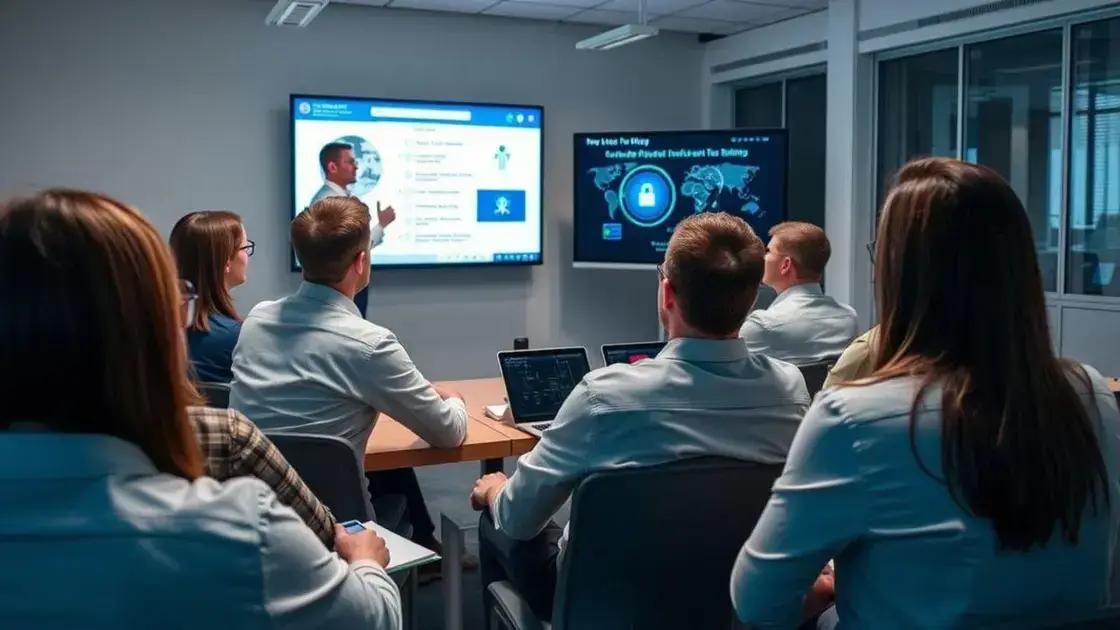Cyber attack prevention: safeguard your digital assets

Anúncios
Effective cyber attack prevention requires a comprehensive strategy that includes incident response planning, employee training, immediate action upon detection, and the utilization of advanced technology for enhanced protection.
Cyber attack prevention is crucial for anyone navigating the digital world today. With increasing threats, knowing how to protect your information can make all the difference. Let’s dive into effective measures that can help safeguard your digital assets.
Anúncios
Understanding the landscape of cyber threats
Understanding the landscape of cyber threats is essential for individuals and businesses alike. As technology advances, so do the tactics used by cybercriminals. Familiarizing yourself with these threats can help you better prepare for potential attacks.
Types of Cyber Threats
There are numerous types of cyber threats that you should be aware of:
Anúncios
- Malware: Malicious software designed to harm your computer or network.
- Phishing: Deceptive messages aimed at tricking you into revealing personal information.
- Ransomware: A type of malware that locks your files and demands payment for their release.
- DDoS Attacks: Overloading a server with traffic to make it unavailable.
Being knowledgeable about these threats can significantly reduce your vulnerability. For instance, malware can enter your system through an unsuspecting email attachment. Meanwhile, phishing attempts often appear to be legitimate requests from well-known companies.
Impact of Cyber Threats
The impact of these threats can be devastating. For individuals, a cyber attack may lead to identity theft or loss of sensitive data. Businesses may face financial losses, reputational damage, and possible legal consequences following a breach.
To navigate this complex landscape, it’s important to employ a combination of strategies. Regularly updating software, training employees on security awareness, and utilizing strong passwords can enhance your defenses against these threats. Furthermore, keeping an eye on emerging trends in cybersecurity can offer insights into new threats and preventative measures.
Key strategies for cyber attack prevention
Implementing key strategies for cyber attack prevention is essential for protecting sensitive information and maintaining business integrity. A proactive approach can significantly decrease the risk of falling victim to cyber threats.
Regular Software Updates
Keeping your software up to date is one of the simplest yet most effective methods for preventing cyber attacks. Software updates often include patches for security vulnerabilities that hackers may exploit. By regularly updating your operating systems and applications, you can mitigate potential risks.
Use Strong Passwords
Creating strong, unique passwords is another crucial strategy. Weak passwords can be easily guessed or cracked, allowing unauthorized access to your accounts. A strong password should include a mix of letters, numbers, and symbols. Additionally, consider using a password manager to help generate and store your passwords securely.
- Mix characters: Combine uppercase and lowercase letters.
- Avoid common words: Stay away from easily guessable phrases.
- Regularly change passwords: Update your passwords periodically to enhance security.
Two-factor authentication (2FA) is an excellent way to add an extra layer of protection. With 2FA, even if someone manages to steal your password, they would need a secondary factor to gain access, such as a code sent to your phone.
Employee Training and Awareness
Another key component in cyber attack prevention is ensuring that all employees are trained in basic cybersecurity practices. Regular training sessions can help your team recognize suspicious activities and understand safe browsing habits. Employees should know how to identify phishing schemes and avoid clicking on unknown links.
It’s also wise to cultivate a culture of security. Encourage your team to report suspicious emails or activities. This proactive approach can help identify potential threats before they escalate into serious issues.
Importance of employee training in security

Employee training in security is critical for maintaining a strong defense against cyber attacks. When employees are knowledgeable about potential threats, they become the first line of defense for the organization.
Why Training Matters
Training helps employees recognize and respond to security threats effectively. Without proper training, even the most sophisticated security systems can fail. Employees who understand the risks are more likely to follow security protocols and practices, which can greatly reduce the chances of a successful attack.
Key Training Topics
When developing a training program, consider covering the following key topics:
- Phishing awareness: Understanding how to identify suspicious emails and links.
- Password management: Best practices for creating and managing strong passwords.
- Data handling: Safe methods for storing and sharing sensitive information.
- Incident reporting: Knowing how and when to report security incidents.
Regular training sessions can reinforce these topics. Consider conducting workshops, simulations, and quizzes to keep employees engaged and informed about the latest security threats. Repetition helps solidify knowledge and prepares employees for real-world scenarios.
Creating a Culture of Security
Building a culture of security within the organization encourages employees to prioritize safety. This can be achieved by promoting open communication about security practices and the importance of vigilance. Managers should lead by example, demonstrating secure behaviors and encouraging team members to do the same.
Moreover, recognizing and rewarding employees for their proactive security measures can motivate others to follow suit. Implementing an engaging training program is essential for safeguarding not just individual employees, but the entire organization.
Utilizing technology for enhanced protection
Utilizing technology for enhanced protection is vital in the landscape of cyber attack prevention. Employing the right tools and systems can dramatically bolster security measures against potential threats.
Implementing Firewalls
One of the first lines of defense is a robust firewall. Firewalls monitor and control incoming and outgoing network traffic based on predetermined security rules. They help to prevent unauthorized access to your network and can block malicious traffic.
Adopting Antivirus Software
Antivirus software is crucial for detecting and removing malicious software from devices. Keeping this software updated ensures that it can effectively combat the newest threats. Regular scans and real-time monitoring can help to catch issues before they escalate.
- Real-time protection: Blocks threats as they occur.
- Scheduled scans: Regularly checks for malware.
- System cleanup: Removes harmful files to keep performance optimal.
Using a Virtual Private Network (VPN) is another effective strategy. A VPN encrypts your internet connection, making it difficult for attackers to track your online activities. This is especially important when using public Wi-Fi networks, where data can be vulnerable.
Leveraging Security Information and Event Management (SIEM)
SIEM systems aggregate and analyze security data from across the organization, providing real-time insights. They can detect unusual activity and generate alerts, which enables quicker response to potential threats. Businesses can also benefit from continuous monitoring, which helps in identifying attack patterns and improving overall security posture.
Utilizing automated tools for threat detection can significantly reduce the response time to incidents. Machine learning algorithms can analyze vast amounts of data, identifying anomalies that a human might miss. This advanced technology helps organizations stay ahead of evolving cyber threats, enhancing their defensive strategies.
Responding to a cyber attack effectively
Responding to a cyber attack effectively is crucial for minimizing damage and recovering quickly. When an attack occurs, time is of the essence, and having a well-prepared response plan can make all the difference.
Establishing an Incident Response Plan
Having an incident response plan is fundamental. This plan should outline the steps to take once a cyber attack is detected. Key elements of an effective plan include clear definitions of roles and responsibilities among team members, ensuring everyone knows their tasks during a crisis.
Immediate Steps to Take
Once an attack is identified, the immediate response should aim to contain the threat:
- Isolate affected systems: Disconnect the compromised systems from the network to prevent further damage.
- Assess the situation: Determine the nature and extent of the attack.
- Notify key stakeholders: Inform your internal team and any relevant external parties, such as law enforcement.
After the situation has been contained, further investigation is necessary. Analyzing how the breach occurred can help prevent future incidents. This analysis may involve reviewing logs, interviewing affected users, and understanding any vulnerabilities that were exploited.
Communication During an Attack
Effective communication is essential during a cyber attack. Keeping stakeholders informed can help manage anxiety and ensure everyone is on the same page. Consider using a predefined communication strategy that outlines how and when to share information.
Once the incident is resolved, it’s important to conduct a thorough review of the response. This post-incident analysis should cover what worked well, what didn’t, and how the organization can improve its defenses in the future. Continuous improvement in your security strategy will help fortify your defenses against future cyber threats.
FAQ – Frequently Asked Questions about Cyber Attack Response
What is an incident response plan?
An incident response plan is a documented strategy that outlines how to handle cybersecurity incidents, detailing steps for prevention, detection, and response.
How quickly should I respond to a cyber attack?
You should respond immediately upon detecting a cyber attack to minimize damage. Quick action can help contain the threat effectively.
What are the first steps to take during a cyber attack?
The first steps include isolating affected systems, notifying key stakeholders, and assessing the situation to understand the extent of the attack.
Why is communication important during a cyber attack?
Communication is essential to keep all stakeholders informed, manage anxiety, and ensure coordinated actions to respond to the attack effectively.






